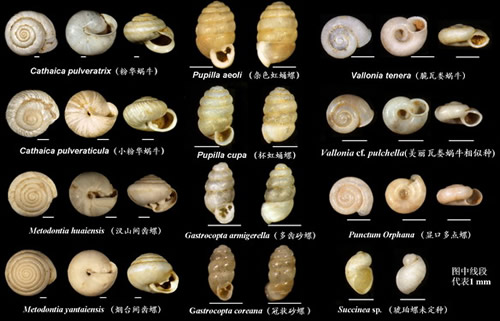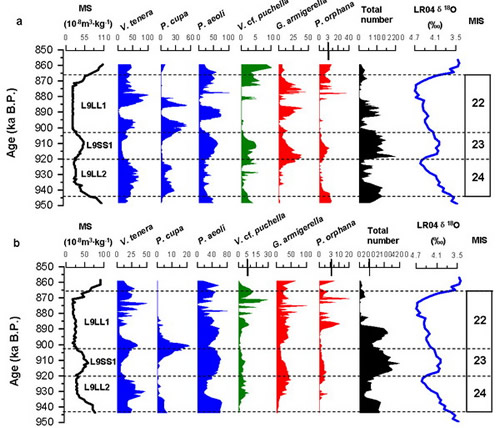Terrestrial mollusc records from Xifeng and Luochuan L9 loess strata and their implicationsUpdate time:05 27, 2011
Ph.D. student WU Bin and his teacher WU Naiqin research the terrestrial mollusc records from Xifeng and Luochuan L9 loess strata. Their study shows that climatic conditions in the Loess Plateau during the L9 loess forming period were similar to that of gentle glacials (MIS 24 and MIS 22) and interglacial (MIS 23), as suggested by the marine record. Three cooling fluctuations occurred at ~930 ka, 900 ka and 880 ka, which might hint to the global “900 ka cooling event”. The “900-ka event” in the Loess Plateau does not seem to be a simple long glaciation, but rather several complex climatic fluctuations superposed on a general coolingtrend. The uplift of the Tibetan Plateau and the general cooling experienced by the Earth during this period may haveresulted in abundant dust sources and increased dust transport capability, as indicated by increased grain size and the mass accumulation rate of L9 loess. Wu and Wu. Terrestrial mollusc records from Xifeng and Luochuan L9 loess strata and their implications for paleoclimatic evolution in the Chinese Loess Plateau during marine Oxygen Isotope Stages 24-22. Climate of the Past, 2011, 7(2): 349-359 (Download Here) Fig1. common snail fossils illustrated pictures of L9 loess (Image by WU)
Fig2.Variations in the percentages of six mollusc species in the Xifeng (a)and Luochuan (b)loess sequences during MIS 24-22, compared with the variations in magnetic susceptibility and LR04 record (Lisiecki and Raymo, 2005). The three ecological groups aredistinguished by colours (blue for cold-aridiphilous, green for cool-humidiphilous and red for thermo-humidiphilous). (Image by WU)
|
Contact
Related Articles
Reference
|
-
SIMSSecondary Ion Mass Spectrometer Laboratory
-
MC-ICPMSMultiple-collector ICPMS Laboratory
-
EM & TEMElectron Microprobe and Transmission Electron Microscope Laboratory
-
SISolid Isotope Laboratory
-
StIStable Isotope Laboratory
-
RMPARock-Mineral Preparation and Analysis
-
AAH40Ar/39Ar & (U-Th)/He Laboratory
-
EMLElectron Microscopy Laboratory
-
USCLUranium Series Chronology Laboratory
-
SASeismic Array Laboratory
-
SEELaboratory of Space Environment Exploration Laboratory
-
PGPaleomagnetism and Geochronology Laboratory
-
BioMNSFrance-China Bio-mineralization and Nano-structure Laboratory

 Print
Print Close
Close

